James Counter Norsworthy 1846-1936
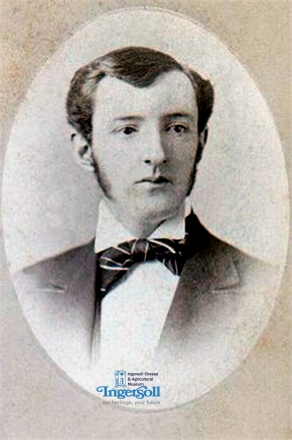 James Counter Norsworthy, emigrated to Middlesex County in 1852 at the age of 6, together with his parents, John & Mary Norsworthy. The Norsworthy clan originated from Widecombe-in-the-Moor, Devon, England.
James Counter Norsworthy, emigrated to Middlesex County in 1852 at the age of 6, together with his parents, John & Mary Norsworthy. The Norsworthy clan originated from Widecombe-in-the-Moor, Devon, England.
James was one of eleven children eventually born to John & Mary; who upon their arrival in North Dorchester Township, purchased a farm in the Thamesford area.
above, Historical County Map of Oxford County, Published by Tremaine, 1857
In 1868, at age 22, James moved to Ingersoll and, in partnership with Elias C. Harris, established an insurance agency. In 1873 he bought Harris’s half of the business, and in 1877 he erected the Norsworthy Building at 17 King Street West.
above, from the Ingersoll Chronicle, 4 January, 1877
above, 17 King Street West, Ingersoll
above, J. C. Norsworthy, Banker & Broker, advertising from the Ingersoll Chronicle 1877-1888
On 26 April 1878, James married Mary Jane Cuthbert (1853-1891) of West Oxford Township.
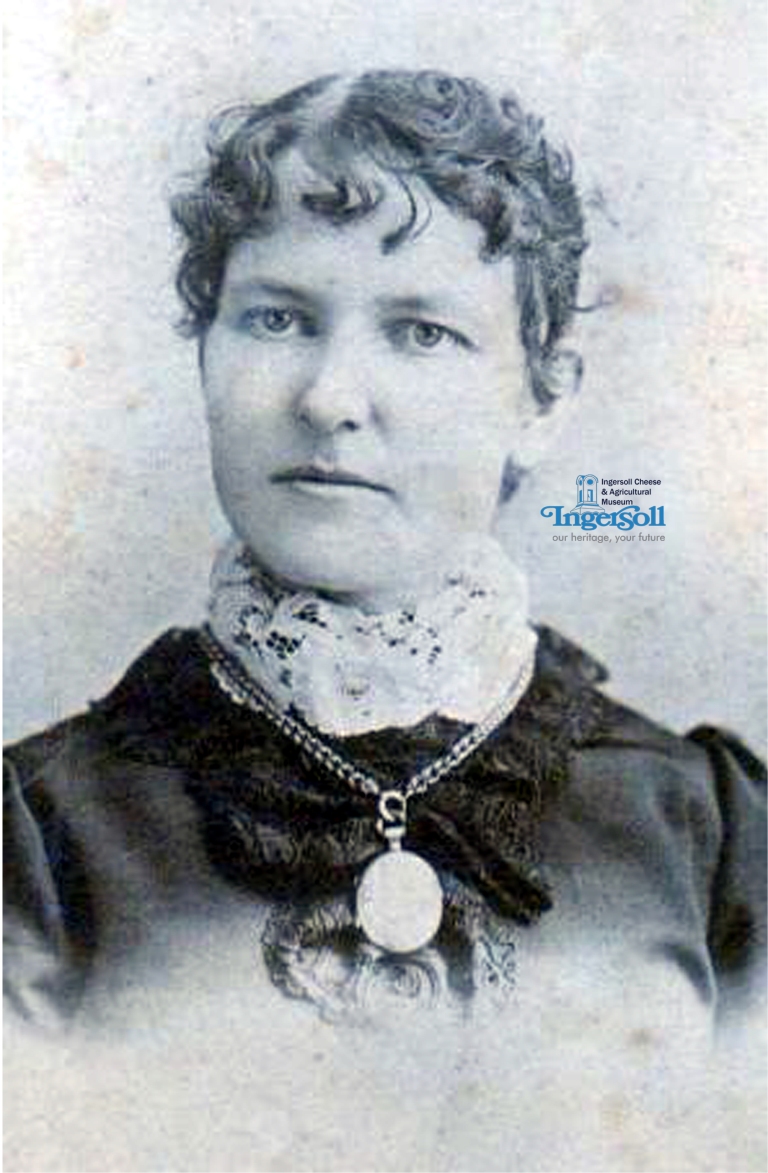

Owned by Mary Jane’s father, Alexander Cuthbert, was a house situated at 250 King Street East. Built in the 1850s by Nathaniel Whiting, a noted Ingersoll pioneer – this home became part of her dowry.
James apparently loved the home and spent much time and money on the improvement of both house and grounds, considered then one of the most attractive in Ingersoll.
James & Mary Jane christened their home ‘Norleigh‘.
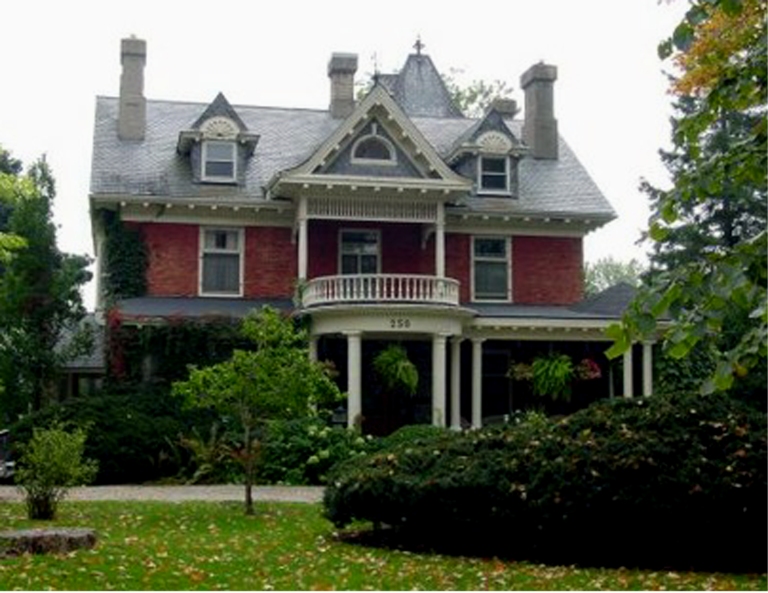
Reportedly James kept a carpenter employed for an entire year working on the house, and a noted artist and wood carver, Frank Leake, produced its elaborately designed fireplace mantles. Together, in the comfort of this house with its running water gravity-fed by overhead cisterns, James and Mary Jane would raise four sons and one daughter before her tragic and sudden death at the age of 38 in February of 1891. It was reported that she had been nursing her daughter through a malignant bout of diphtheria and while seven year old Helen survived, her mother contracted the illness and died.
Children of James & Mary Jane:
Edward Cuthbert Norsworthy 1879-1915
Stanley Counter Norsworthy 1881-1966
Helen Alice Norsworthy 1884-1970
Alfred James Norsworthy 1887-1917
John Weldon Norsworthy 1890-1975
With the death of their mother, they went out of town to private schools, Eddie to Upper Canada College, Toronto, and Stanley, after a year as a bank clerk in Ingersoll, to Ridley College in St. Catharines. The two older boys had attended the Ingersoll Central School, Eddie (1886-1890) and Stanley (1889-1890). Their father may also have chosen private schools to fit his boys for financial careers outside of the town. Alfred, Weldon, and Helen logged some years in the local Ingersoll school during the years 1896-1898. Then Weldon went off to Ridley and Nellie to Havergal College in Toronto. Where Alfred was educated is not mentioned.
In 1890 James sold his insurance business in Ingersoll to David G. Cuthbertson (1864-1945) to become a chief inspector with the North British and Mercantile Insurance Company: “He travelled much, over the length and breadth of Canada, and acquired a wide and sympathetic knowledge of the Dominion, its history, people and business conditions.”
In May, 1895, James married Jane Elizabeth (Jennie) Taylor (1860-1951), relict of James T. McDonald (1846-1893), a ship captain in Sarnia. With his second marriage, James changed the family religious affiliation from Presbyterian to Anglican.
In 1905 James retired to ‘Norleigh‘ in Ingersoll. There he remained through to his death in 1936.
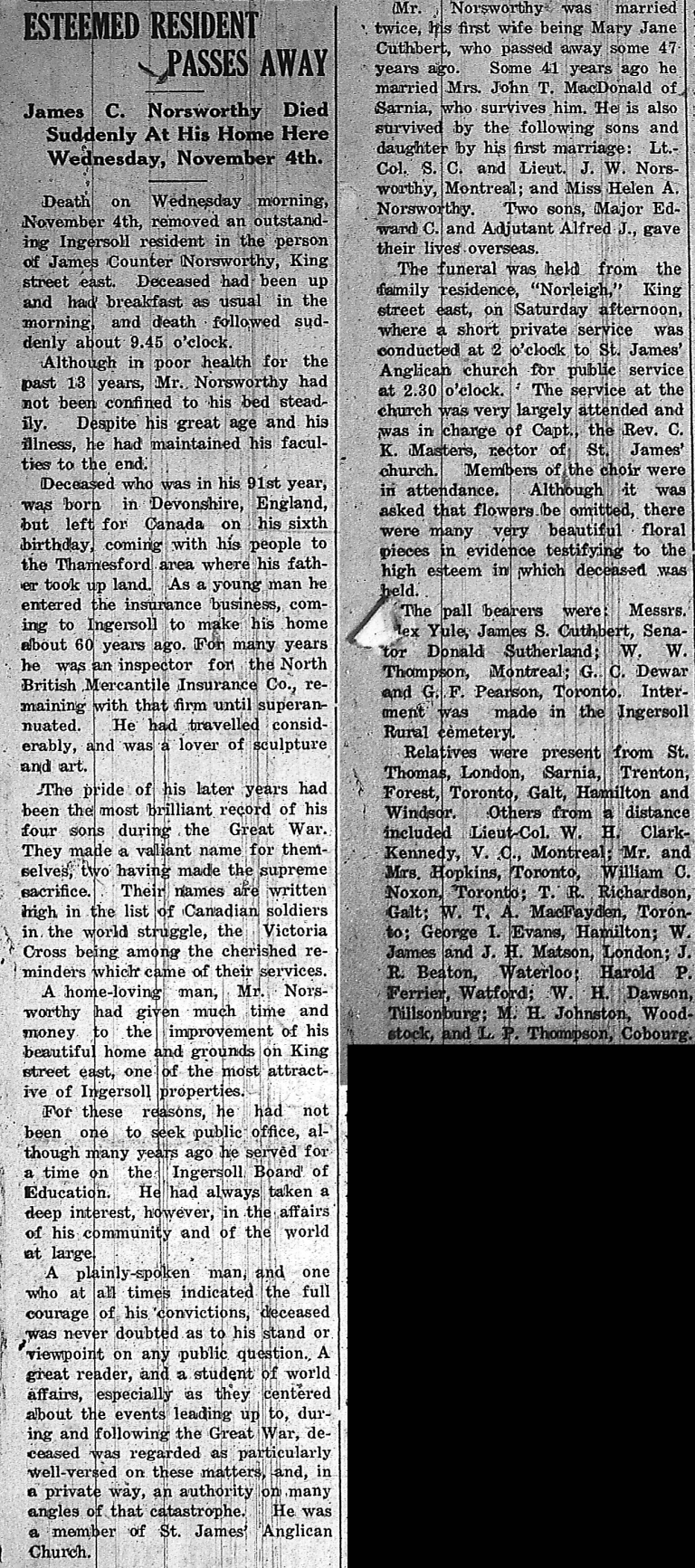
above, James C. Norsworthy’s obituary from the Ingersoll Tribune, 12 November 1936
above, James’s memorial plaque on the Norsworthy monument, Ingersoll Rural Cemetery, as well as that of his wives, Mary Jane Cuthbert & Jane Elizabeth Taylor.
The Norsworthy Children
In March, 1909, James wrote a brief sketch of his family, which then consisted of: Edward Cuthbert, Stanley Counter, Helen Alice, Alfred James, and John Weldon. The four sons are now residing in the city of Montreal, Canada, Edward as manager at Montreal of the Dominion Securities Corporation, Stanley C. as clerk on the staff of the Bank of Montreal, Alfred J. on the staff of the Molson’s Bank of Canada, John W. as clerk on the staff of the Canadian Bank of Commerce, all unmarried.” In 1909 Edward was 30, Stanley 28, Alfred 22, and Weldon, 19. Their business careers were flourishing, but they were primed for the Great War, their theatre for sacrifice and glory.
above, four Norsworthy sons photographed in Highlander uniforms of the Black Watch.
Edward Cuthbert Norsworthy 1879-1915
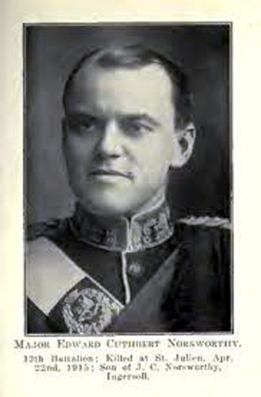
Edward was born 29 May 1879 in Ingersoll, Ontario. After public school in Ingersoll, he went to Upper Canada College eventually becoming a broker in the business world. He never married.
With the advent of the war, he signed his attestation papers on 23 September 1914 at Valcartier, Quebec.
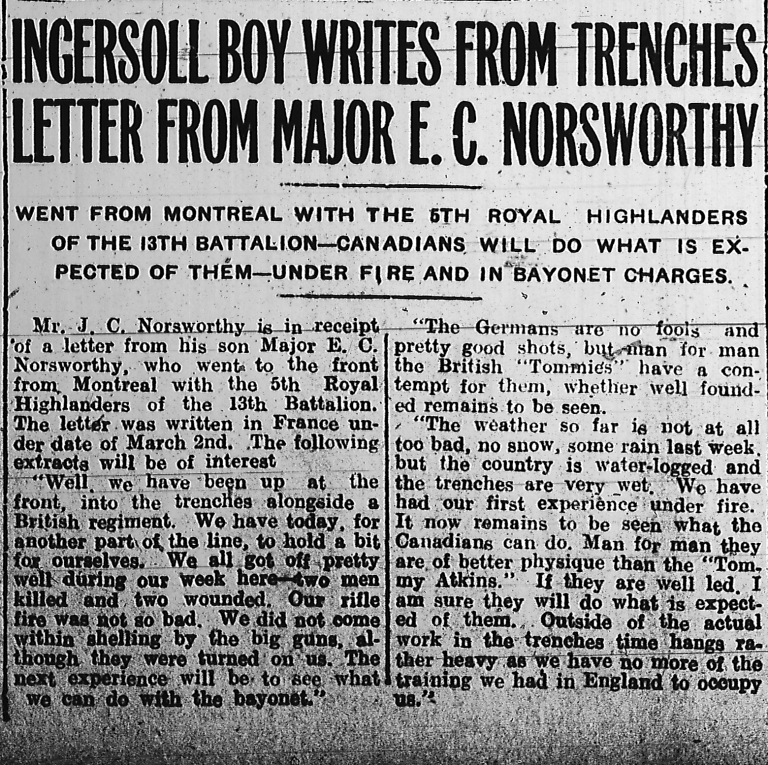
above, a letter from Edward Norsworthy, published in the Ingersoll Chronicle, 25 March 1915
Published in the Ingersoll Chronicle, 6 May 1915; Edward’s last letter to his father was written in the trenches of Ypres on 9th of April and in it he said some things worth remembering:

Major Edward Cuthbert Norsworthy died at Langemark, the Second Battle of Ypres, on 22 April 1915.
Various histories of the Royal Highland Regiment of Canada affiliated with the Black Watch refer to how well admired and respected Edward was by all the men under his command – both fellow officers and infantrymen. (He was Second in Command of his regiment.) The Second Battle of Ypres was the first time that Canadians had been engaged in active battle since the war began. The few eye witnesses who survived the opening night of the battle, when Germans unleashed poisonous gas for the first time, described Edward as a man who led by example. Even though wounded by a bullet to the neck, he continued to inspire his men to hold the line, with the words “All of Canada is watching” — an indication that he knew the efforts of the Canadian troops would be known and debated, whatever the result. That night, April 22nd, 1915, Edward Norsworthy succumbed to his wounds and along with him, many other men who were described as the cream of Canadian society.
Through Edward’s fellow Masonic brethren in Montreal, a bust of Edward was created by noted bronze sculptor Hamilton Thomas Carlton Plantagenet MacCarthy. Edward had been initiated into Masonry at St. Paul’s Lodge in Montreal and records indicate that they coordinated the creation and erection of the bust through the two Masonic lodges in Ingersoll. Three years to the day after Edward was killed in action, his life-like effigy was unveiled to the public, under the auspices of the Grand Lodge of Canada in the Province of Ontario. The bust of Edward, atop the family monument at Ingersoll Cemetery, looks toward the south east and his boyhood home, ‘Norleigh’.
above, Edward’s memorial plaque on the Norsworthy monument, Ingersoll Rural Cemetery
Seven years later, on 10 February 1922, his father received a letter informing him that, “during exhumation work in Flanders a grave has been discovered containing the remains of a Major of the Royal Highlanders of Canada.” Based on evidence they believed it to be the body of his son. He was subsequently buried at Tyne Cot, Flanders, Belgium.
text above from: The Family of John Norsworthy and Mary Caunter by Anne Brooks
Stanley Counter Norsworthy 1881-1966
Stanley was born on 13 December 1881 in Ingersoll. After leaving Ridley College at the age of sixteen, he entered the service of the Bank of Montreal on 1 August 1898, and was first stationed at London, Ontario. From there he went to Halifax, Nova Scotia, to St. John’s, Newfoundland, and then to the accountant’s department in the Montreal Branch.
He spent two years at a branch in London, England and then to the Mexico City Branch where he was a manager for four years.
It was during this time he returned to Canada to enlist for overseas service.
He signed his attestation papers on 3 June 1915 in Montreal, Quebec at the age of 33.
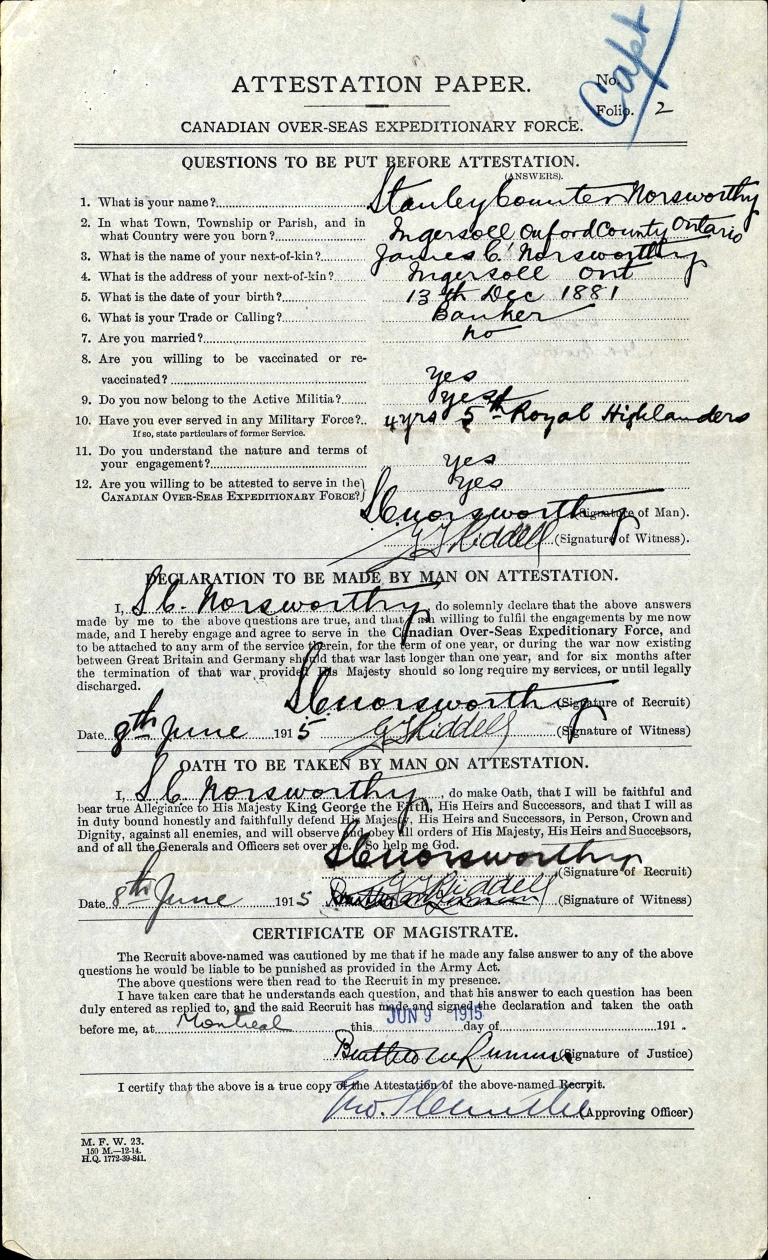
He married Georgina Maud Sankey, daughter of Villiers and Ann Sankey in London, England on 26 July 1916. Their children were Edward Cuthbert Villiers, born in 1917 and presumably named in honor of his brother, Beatrice Mary, and Hugh Hoyles.
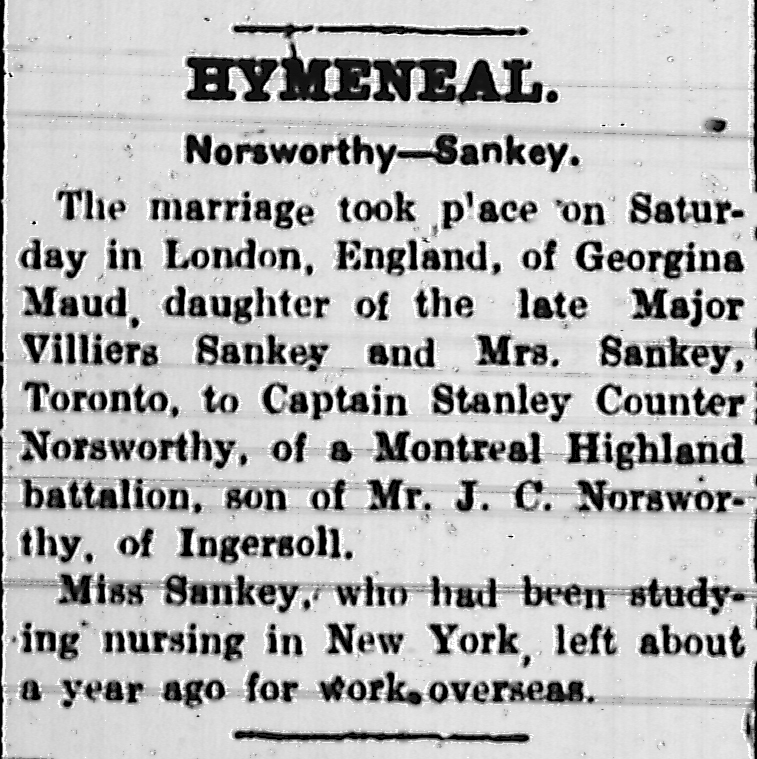
above, from the Ingersoll Chronicle, 27 July 1916, marriage notice of Stanley Norsworthy
In the Battle of the Somme, Stanley was second in command of his battalion and at Courcelette, on September 16th was wounded and spent two months in hospital. He was awarded the Military Cross, for conspicuous gallantry in action. He took personal supervision of the operations in the front line, displayed great courage and initiative. Later, though wounded, he remained at duty. He set a fine example of coolness
and devotion to duty throughout”. He returned to France on January 2, 1917 as Acting Commander of the Battalion during the winter of 1917 and through the Battle of Vimy Ridge – for which latter action he was granted the D.S.O. On November 22, 1917, Major Norsworthy was invested at Buckingham Palace, by His Majesty the King.
Toronto Globe, 19 October, 1928
Upon his return from overseas, he was appointed Inspector of the Foreign Department at the head office and later as Third Agent at New York. In December, 1921 when the Merchants Bank of Canada was acquired, Mr. Norsworthy returned to Montreal to act temporarily as Assistant General Manager of the Merchants Bank of Canada. In 1922 he was appointed District Superintendent of the Ontario District, with headquarters in Toronto.
Stanley died on 25 December 1966, and is buried at Ingersoll Rural Cemetery.
above, Stanley’s memorial plaque on the Norsworthy monument, Ingersoll Rural Cemetery
text above from: The Family of John Norsworthy and Mary Caunter by Anne Brooks
Helen Alice Norsworthy 1884-1970
Helen, the only daughter in the family, was born on 4 May 1884. She was educated at the public school and Collegiate Institute in Ingersoll and spent two years at Havergal College, Toronto. She then took up nursing as a profession, was trained at the Western Hospital, Montreal, where she proved a bright student and earnest worker and graduated in due course.
above, Graduation photo from nursing school in 1905.
Associated with other friends she pursued her work so energetically and, especially in connection with some serious typhoid cases that her health broke down and she had to return home. The anxieties of the war period and the absence at the Front of so many members of the family circle prevented the complete recovery which had been hoped for.
Helen died 25 June 1970 and is buried at Ingersoll Rural Cemetery.
above, Helen’s memorial plaque on the Norsworthy monument, Ingersoll Rural Cemetery
text above from: The Family of John Norsworthy and Mary Caunter by Anne Brooks
Alfred James Norsworthy 1887-1917
Alfred was born on 3 May 1887 in Ingersoll. He was educated at Ingersoll and at Ridley College and served for five years following 1905 in the Molsons Bank. In 1910 he went to the New York office of the British-American Tobacco Company and had risen to a position of importance when he was sent to Costa Rica, Central America, as manager of the sales department in that Republic, and was there when the call of war came.
He signed his attestation paper on 30 October 1915 in Montreal, Quebec.
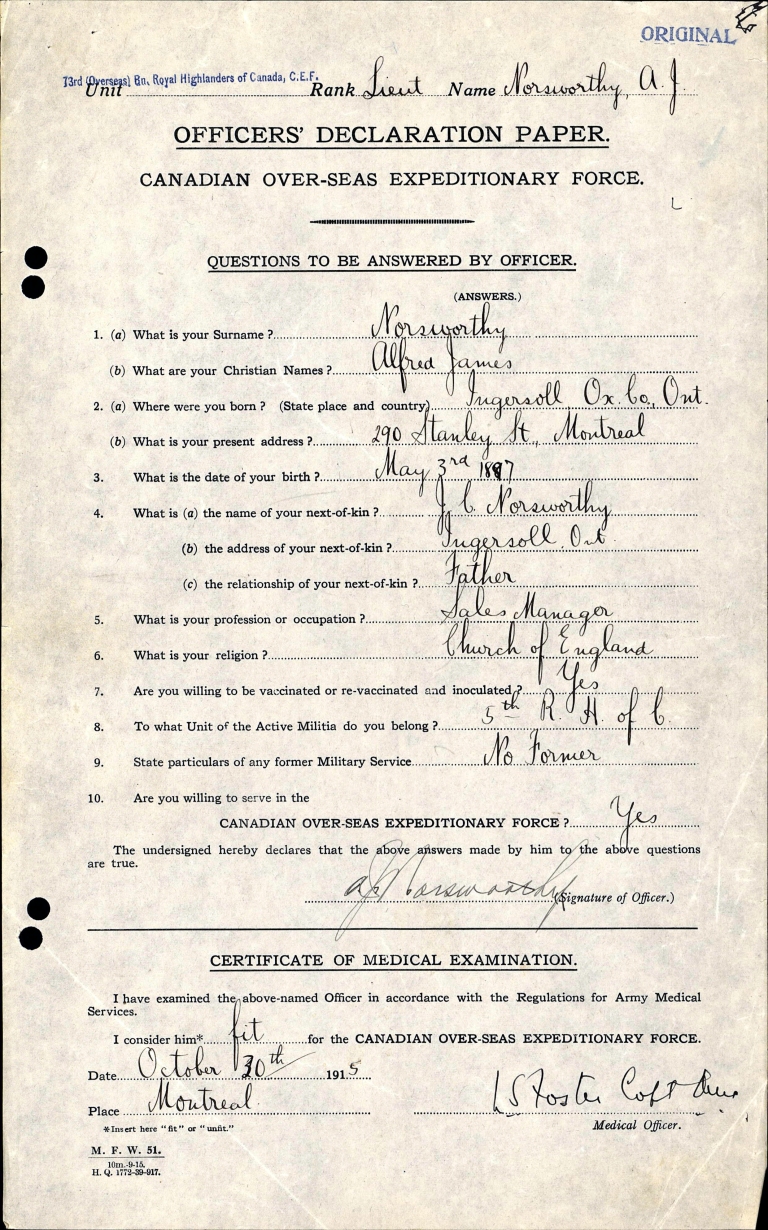
His letters home were characteristic of the pride and affection which the brothers felt for each other. Upon hearing of his brother Edward’s death prior to enlisting, he wrote:
“It is awful to think of, but again, we are here for a few years only and all must go. What a glorious ending to a life that was lived as a man could hope to live. He lived a life that made all his friends justly proud of his acquaintances and died the death of a soldier fighting for his country and for the right”.
Alfred died on 29 March 1917, and was buried in the Barlin Communal Extension Cemetery, Barlin, France.

above, from the Ingersoll Chronicle, 5 April 1917, obituary of Alfred Norsworthy.
above, Alfred’s memorial plaque on the Norsworthy monument, Ingersoll Rural Cemetery
text above from: The Family of John Norsworthy and Mary Caunter by Anne Brooks
John Weldon Norsworthy 1890-1975
John was born on 13 March 1890 in Ingersoll. He married Marjorie Wilson Goldie and they had one known daughter, Mary Joan.
John signed his attestation papers on 29 May 1916 in Montreal, Quebec.
He was in the same battalion with his brother, Alfred. He served with him, worked with him, helped to bury him and was wounded shortly afterwards in the historic Vimy charge. After partial recovery from his wound, John returned to Canada in July 1917. In September, the restless young soldier, unable to go to the Front, was allowed to accept work as Training Officer for United States troops at Union College, Schenectady, New York, and remained there until February 1919; he was then attached to the British and Canadian Recruiting Mission stationed at Providence, Rhode Island, and later at New Haven, Connecticut.
John died 7 January 1975, and is buried with his wife at Ingersoll Rural Cemetery.
above, John Weldon’s memorial plaque on the Norsworthy monument, Ingersoll Rural Cemetery
text above from: The Family of John Norsworthy and Mary Caunter by Anne Brooks
100 YEARS LATER: MEMORIALIZATION
A hundred years after Edward Cuthbert Norsworthy’s monument was officially unveiled, the Town of Ingersoll and Masons rededicated his tomb at the Ingersoll Rural Cemetery.
The Sunday afternoon ceremony took place 100 years to the day after the initial unveiling of the bust and exactly 103 years after his death at the Second Battle of Ypres.
The event was part of the Oxford Remembers Oxford’s Own project that’s been ongoing since 2014 to commemorate the 100 years since the First World War.
“This year is the culmination of four years (of Oxford County’s remembrance) and it ties in nicely to the travelling exhibit looking at the men who came back from war and those who were killed were commiserated by their communities,” Ingersoll Museum curator Scott Gillies said before the re-dedication, noting the anniversary falling on a weekend made it good timing to hold.
Gillies said they contacted dignitaries with the Masons to speak on the anniversary, with Deputy Grand Master David J. Cameron reading the same address from 100 years ago given by the then Grand Master. Several Masons were on hand as well as locals for a crowd of about 100 people.
Norsworthy was born in 1879 and was the oldest son of Ingersoll businessman J. C. Norsworthy. He attended school in Ingersoll and Toronto’s Upper Canada College then finally McGill University in Montreal before joining the family business as a banker and insurance broker in Montreal.
When the First World War broke out, he joined the 13th Battalion of the Royal Highlanders of Canada – the Black Watch Regiment – Sept. 23, 1914, and was appointed the battalion’s second-in-command at the rank of Major. Norsworthy led about 100 men of two platoons on April 22, 1915, against a force of German infantry during the first use of poisonous gas at the Second Battle of Ypres. He was killed in action the same day in the area of Langemarck, about 10 kilometres north of Ypres in northwestern Belgium.
The battle continued for more than a month and led to roughly 60,000 British and Commonwealth Forces, including about 6,500 Canadian casualties – more than 2,000 of which were killed in action – 22,000 French casualties and about 35,000 German casualties in what ultimately served as an allied victory.
The plaque on his grave marks he was mentioned in despatches by Field Marshal Sir John French “for gallant and distinguished service in the field.” The plaque continues with, “Not for fame or reward – not for place or for rank – nor lured by ambition – or goaded by necessity but in simple obedience to duty as he understood it.
Major Norsworthy sacrificed all – suffered all – dared all – and died.”
More can be learned about the Norsworthy family including an archive of letters from the sons, sent home to their father, during World War I, on the Oxford County Library Local History page.
Acknowledgements to: Anne Brooks, author of The Family of John Norsworthy and Mary Caunter; as well as to George Emery, historian; Scott Gillies, curator, Ingersoll Cheese & Agricultural Musuem and to Janice Ferguson developed a lifelong interest in Norsworthy family history after living with her parents at ‘Norleigh’ when the house contained the original furnishings as well as many Norsworthy papers and memorabilia’; they provided the words and inspiration behind the creation of this tribute to the James Norsworthy family of Ingersoll.
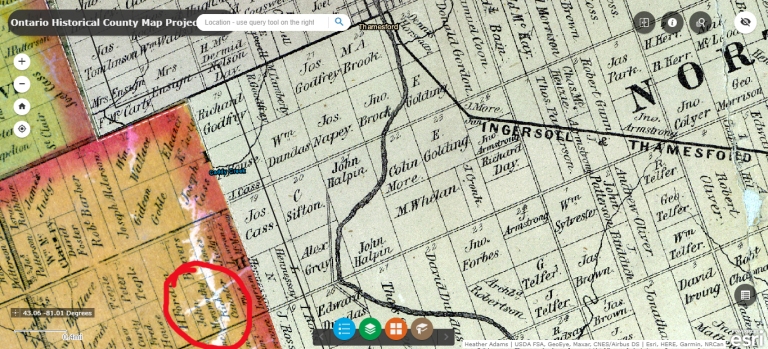
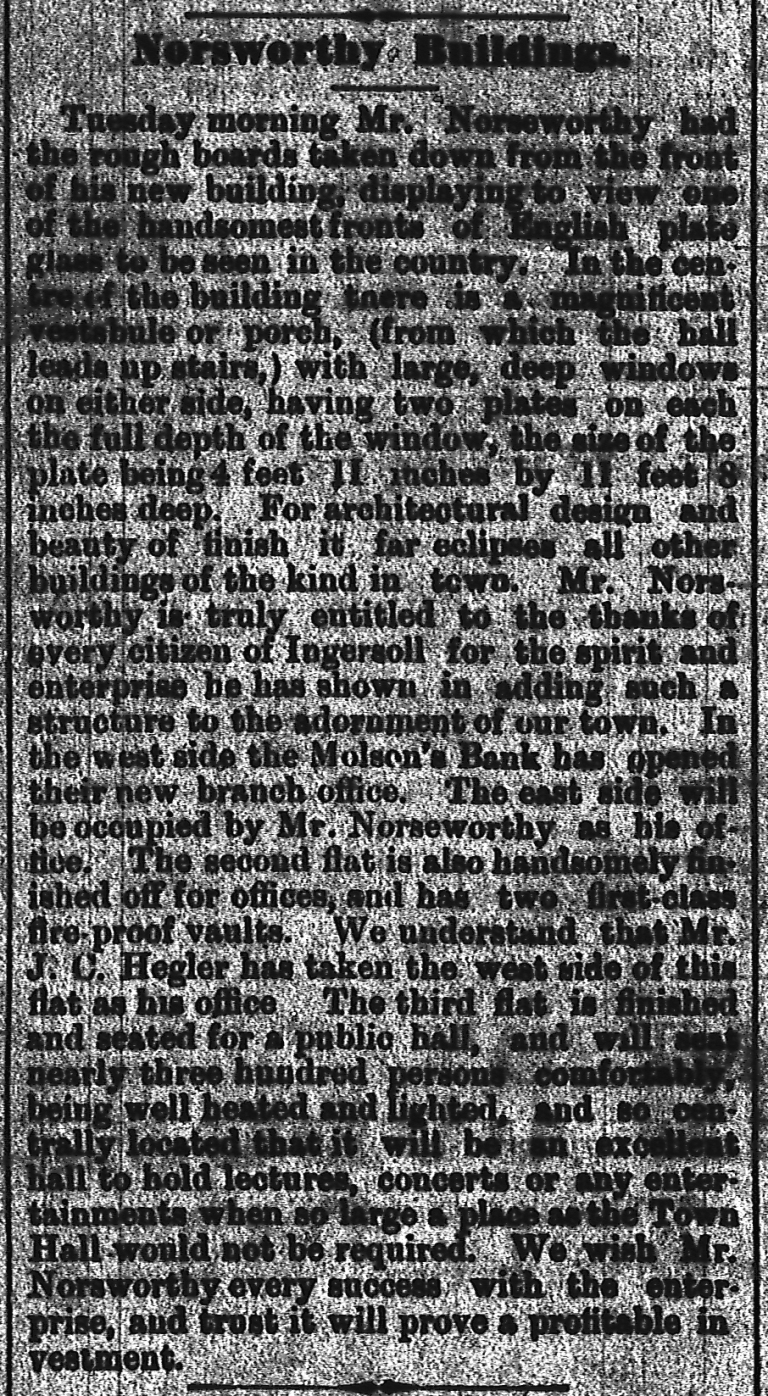
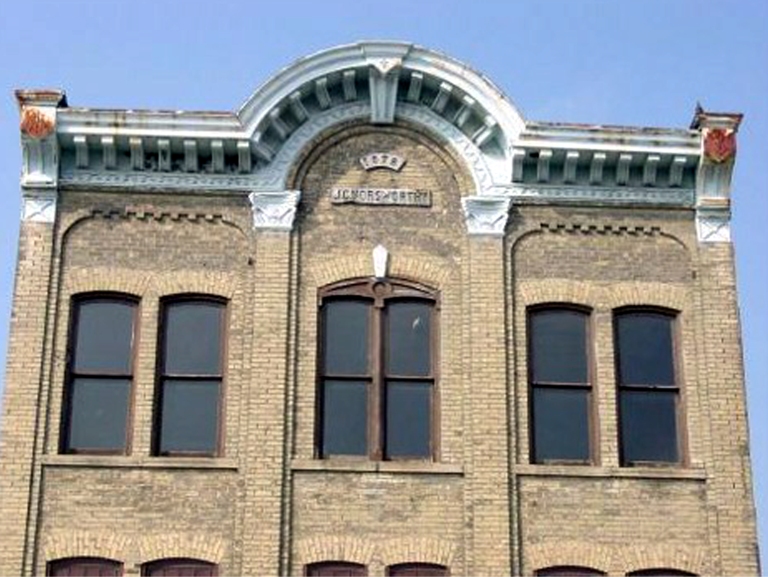





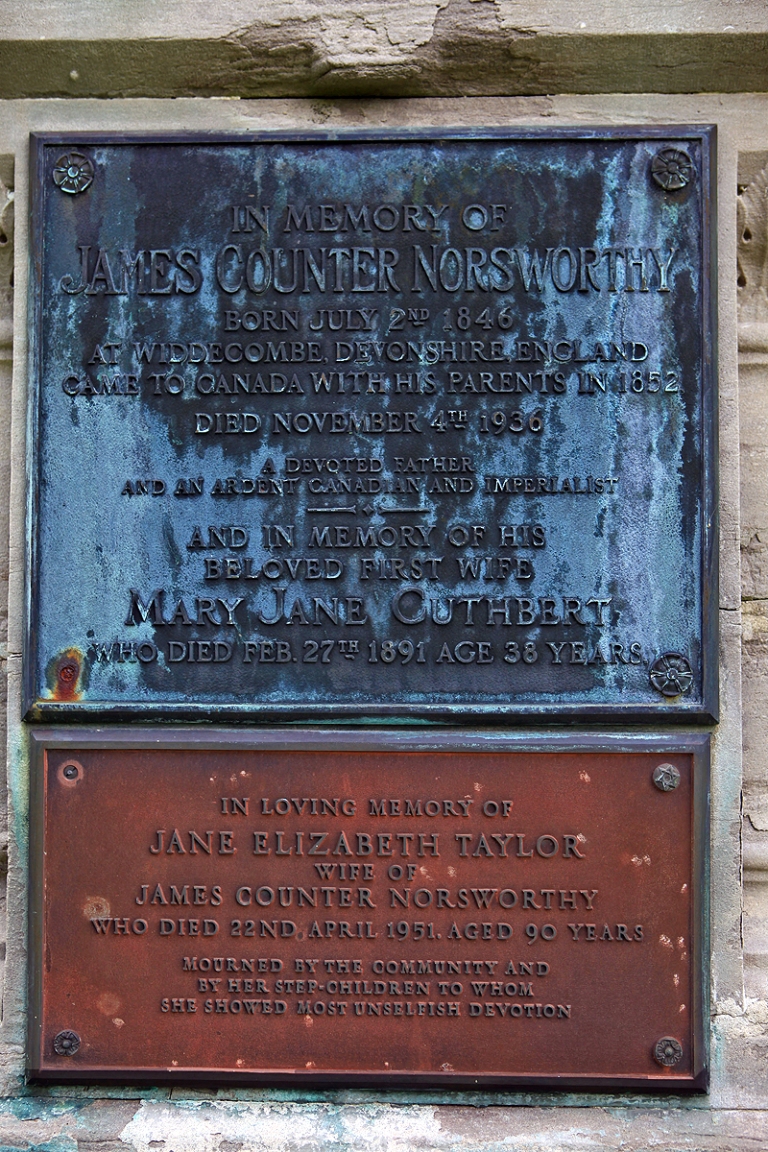
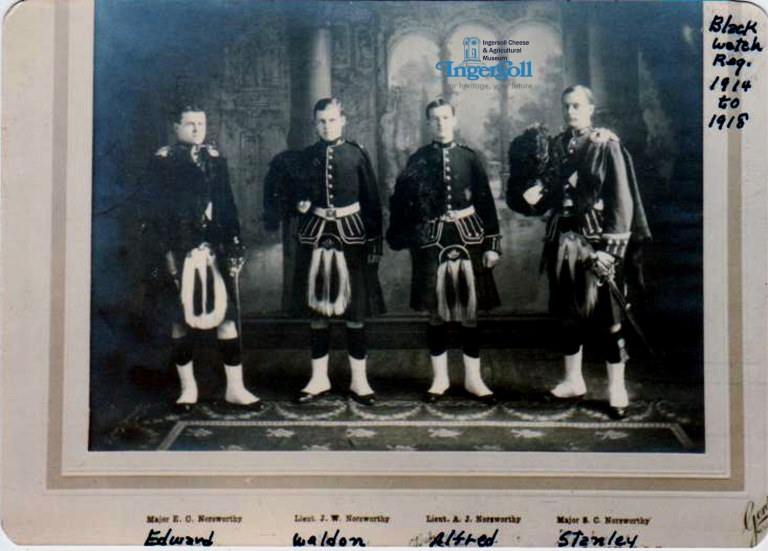
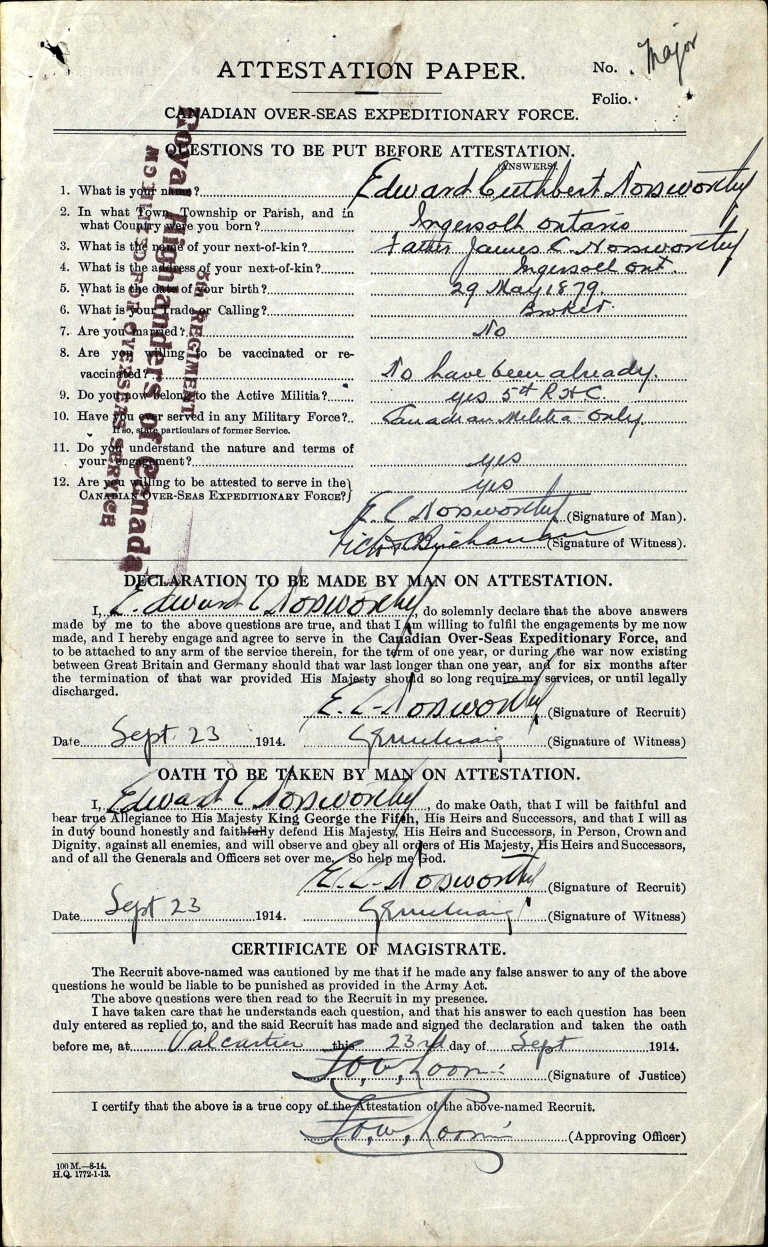
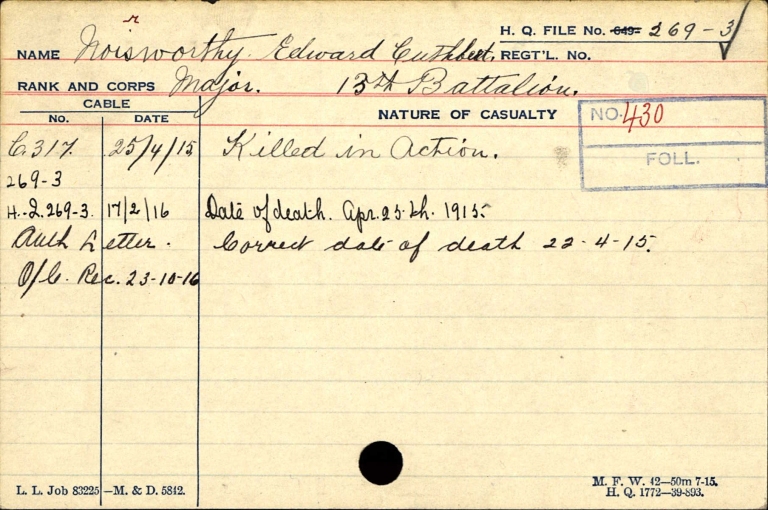
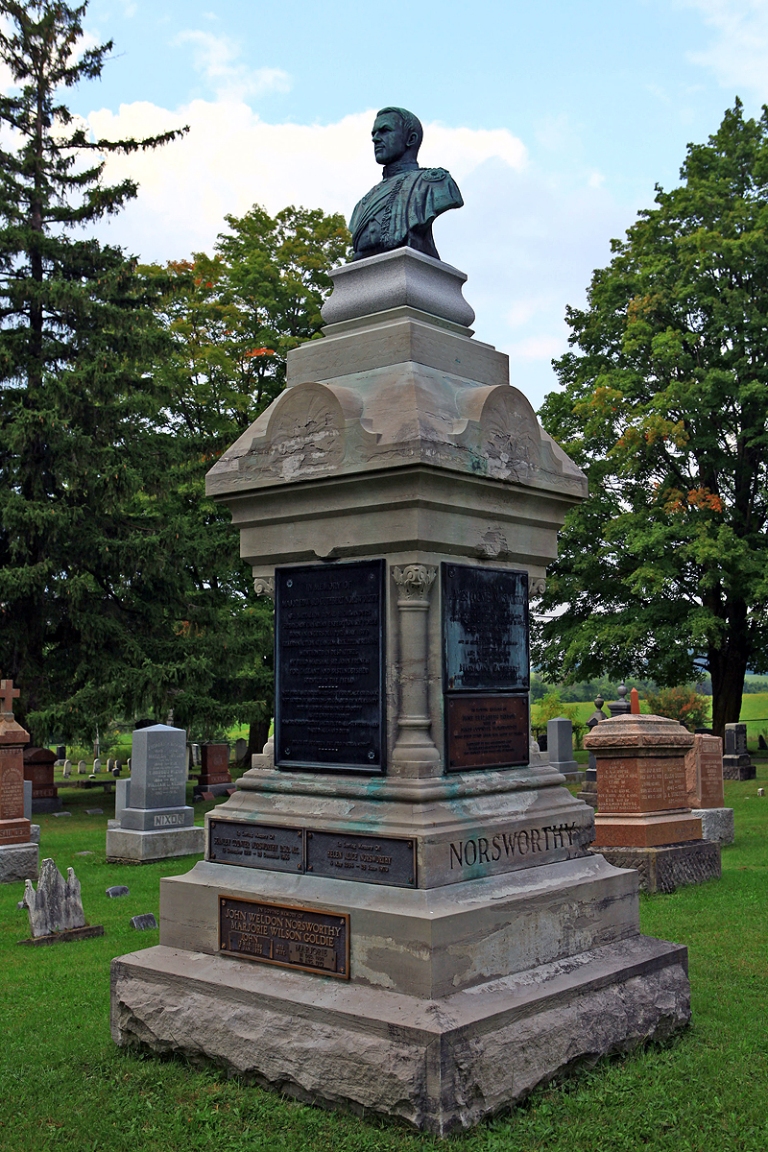
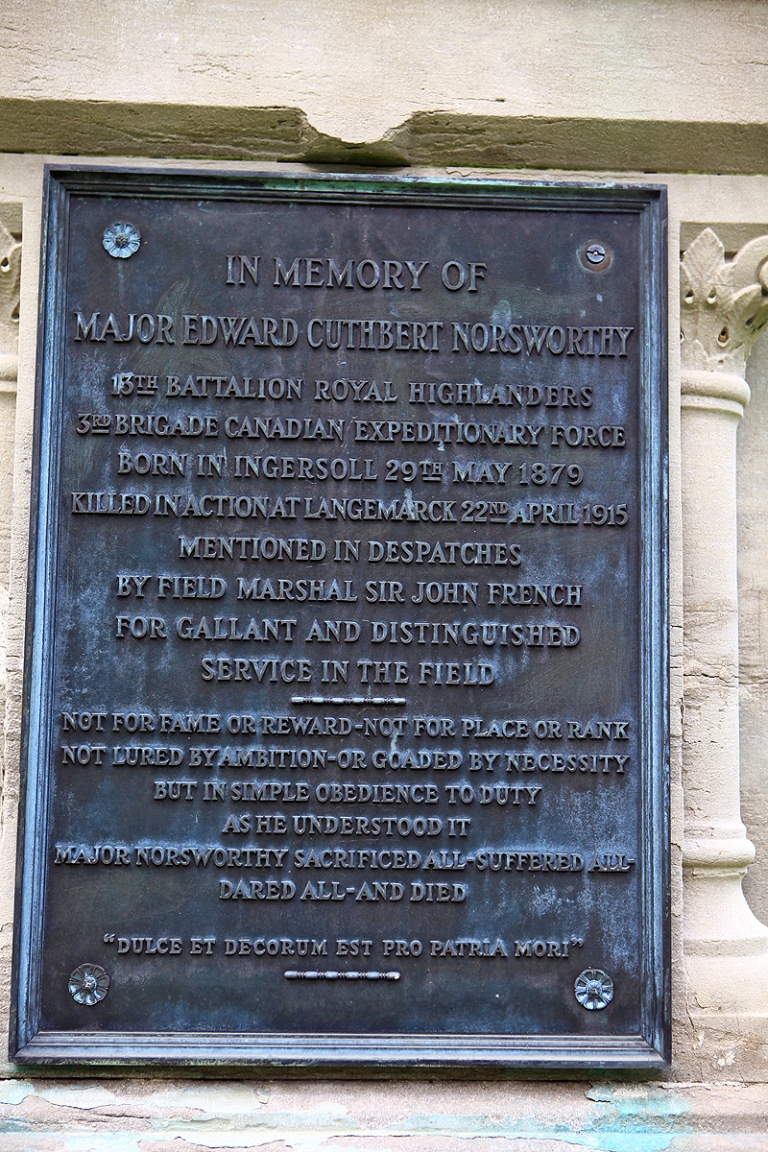
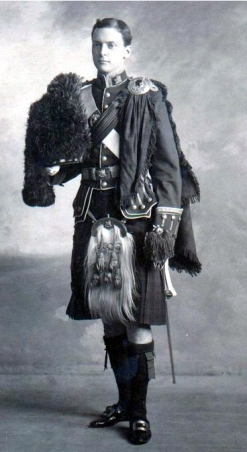
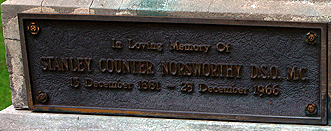
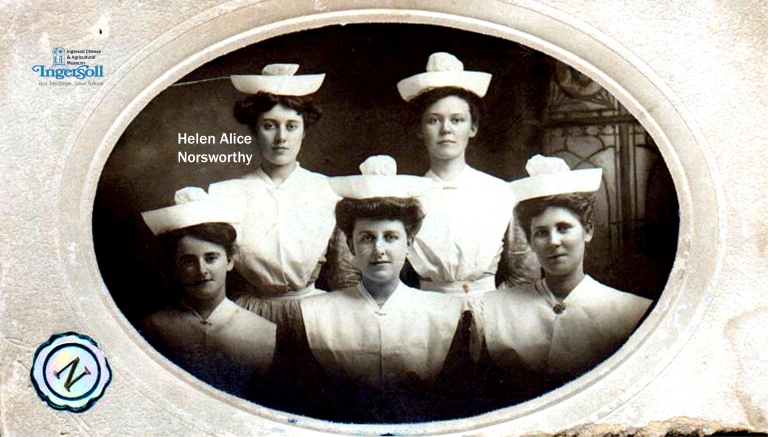
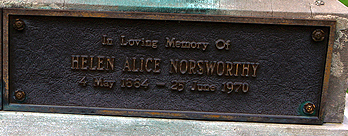
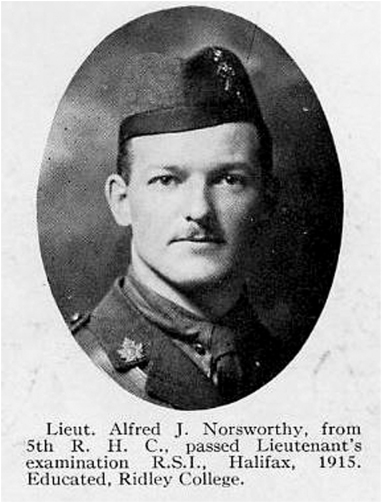

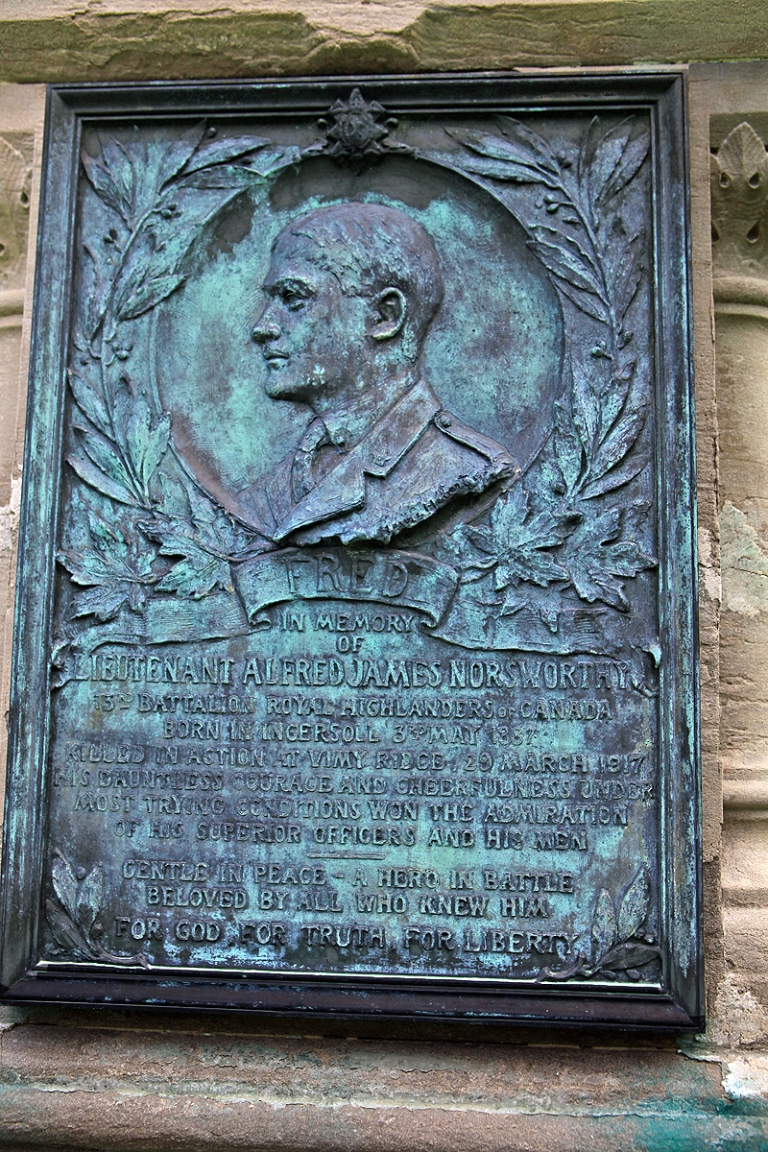
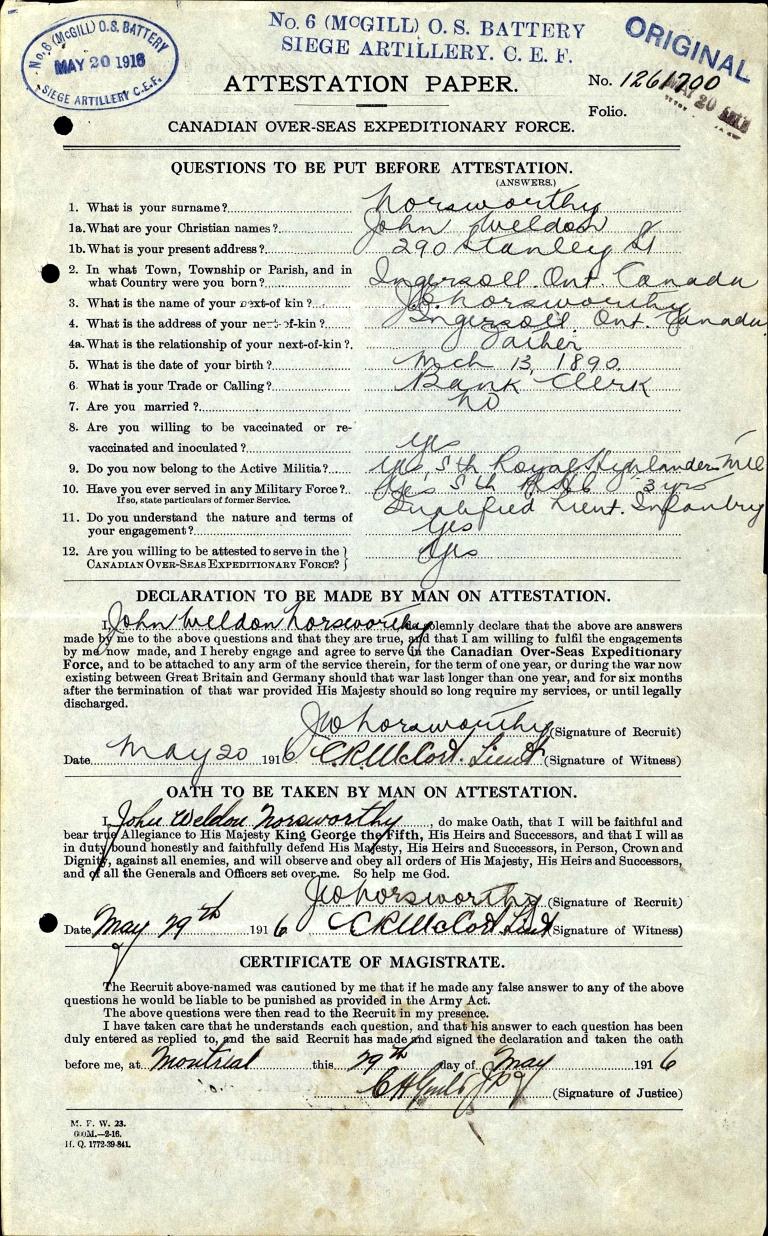
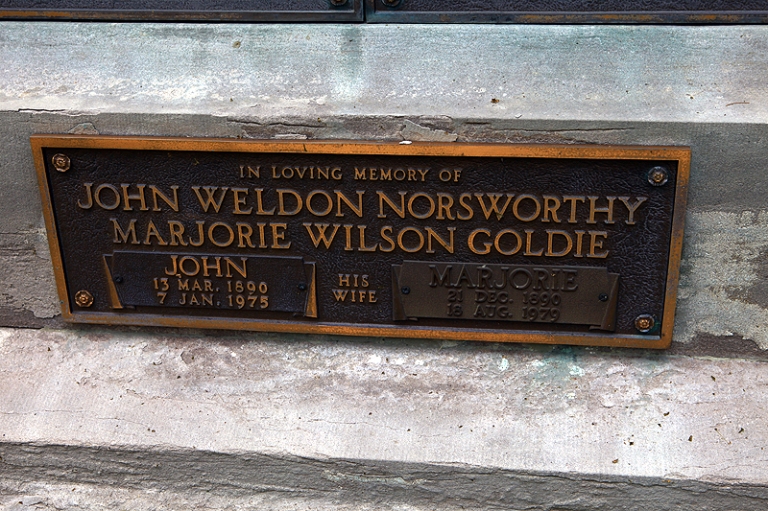
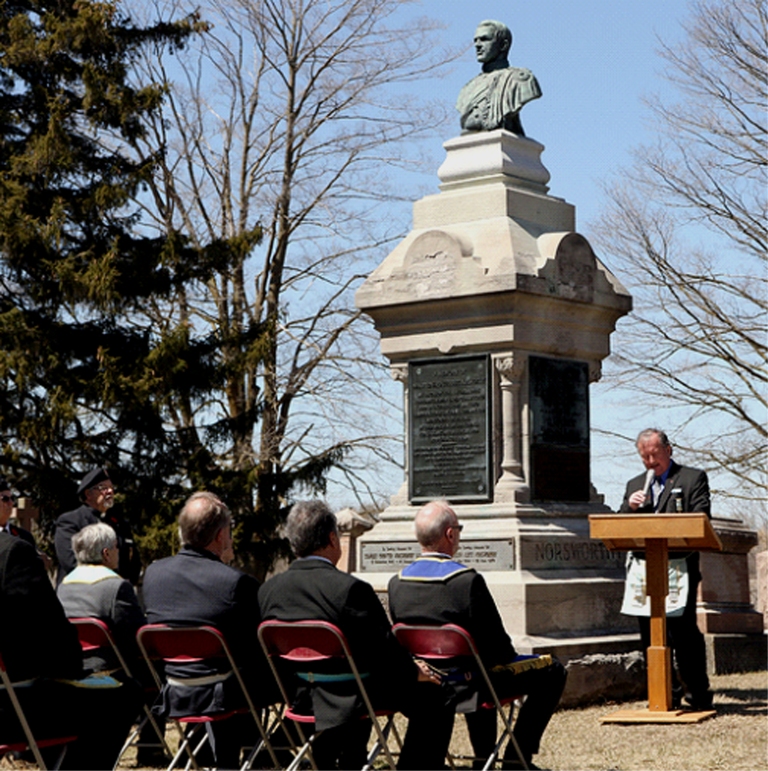
To Whom It May Concern.
Many thanks for sending me these historical moments. I have appreciated reading them and have learned far more about my town from these historical documents than I did whilst I lived in Ingersoll. I will look forward to future postings.
Thank you again for sending these.
Sincerely D. Patricia (Trish) Presswell Strung
>
Love the history of Ingersoll and it’s noteworthy people and events…
Thank you very much for these postings. I was born in Ingersoll in 1935. My father was Arthur Waring, a dentist in Ingersoll. He was born in !891 near Embro then raised near Banner a hamlet west of Ingersoll. Till have his helmet decorations and paybook from his first world war service.
My mother born in 1891 went to school in banner also. My mother lived to 106 yrs. She died here where I live in Cobourg Ont.
I remember the NAME Norsworthy as my mothers chapter of the IOD E was named after that family.
My sister married Paul Ranney whose great grand parents supplied the milk for the big cheese from their farm in Salford. My sister remarked their great grandmother Lydia was the driving force behind that but her husband got all the credit.
We lived at 286 Thames St and I believe the people that lived around the corner were descendants of the Harris family.
Again many thanks as I much enjoy them and send them to my older sister aged 95 who lives on salt Spring Island BC